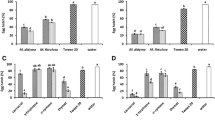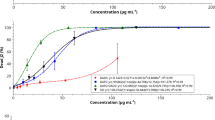Abstract
Ergoline alkaloids are constituents of Clavicipitaceous fungi living on Poaceae plants. Ergoline alkaloids as well as volatile oil are also present in Ipomoea asarifolia Roem. & Schult (Convolvulaceae). Treatment of this plant with two fungicides (Folicur, Pronto Plus) eliminates the ergoline alkaloids but not the volatile oil. Elimination of ergoline alkaloids occurs concomitantly with loss of fungal hyphae associated with secretory glands on the upper leaf surface of the Ipomoea plant. Our observations suggest that accumulation of ergoline alkaloids in the Convolvulaceae may depend on the presence of a plant-associated fungus.




Similar content being viewed by others
References
Broun P, Somerville C (2001) Progress in plant metabolic engineering. Proc Natl Acad Sci USA 98:8925–8927
Buades C, Moya A (1996) Phylogenetic analysis of the isopenicillin-N-synthetase horizontal gene transfer. J Mol Evol 42:537–542
Bushman F (2002) Lateral DNA transfer. Mechanisms and consequences. Cold Spring Harbor Laboratory Press, Cold Spring Harbor, NY
Caruso M, Colombo AL, Fedeli L, Pavesi A, Quadroni S, Saracchi M, Ventrella G (2000) Isolation of endophytic fungi and actinomycetes taxane producers. Ann Microbiol 50:3–13
Clay K (1991) Fungal endophytes, grasses and herbivores. In: Barbose P, Krischik VA, Jones CG (eds) Microbial mediation of plant–herbivore interactions. Wiley, New York, pp 199–226
Clay K, Frentz IC (1993) Balansia pilulaeformis, an epiphytic species. Mycologia 85:527–534
Davidse LC (1987) Biochemical aspects of benzimidazole fungicides-action and resistance. In: Lyr H (ed) Modern selective fungicides. Fischer, Jena, pp 245–257
Dobberstein RH, Staba EJ (1969) Ipomoea, Rivea and Argyreia tissue cultures: influence of various chemical factors on indole alkaloid production and growth. Lloydia 32:141–147
Europäisches Arzneibuch (1997) Amtliche deutsche Ausgabe, 3rd edn. Deutscher Apotheker Verlag, Stuttgart; Govi-Verlag-Pharmazeutischer Verlag, Eschborn, pp 129–130
Frach K, Blaschke G (1998) Separation of ergot alkaloids and their epimers and determination in sclerotia by capillary electrophoresis. J Chromatogr A 808:247–252
Fritz R, Lanen C, Colas V, Leroux P (1997) Inhibition of methionine biosynthesis in Botrytis cinera by the anilinopyromidine fungicide pyrimenthanil. Pestic Sci 49:40–46
Gröger D, Floss HG (1998) Biochemistry of ergot alkaloids—achievements and challenges. In: Cordell GA (ed) The alkaloids, vol 50. Academic Press, San Diego, pp 171–218
Hegnauer R (1992) Chemotaxonomie der Pflanzen. Birkhäuser, Basel
Hochmuth DH, Joulain D, König WA (2002) MassFinder Software and Data Bank, University of Hamburg. http://www.chemie.uni-hamburg.de/oc/koenig/massfinder.html
Jenett-Siems K, Kaloga M, Eich E (1994) Ergobalansine/ergobalansinine, a proline-free peptide-type alkaloid of the fungal genus Balansia, is a constituent of Ipomoea piurensis. J Nat Prod 57:1304–1306
Kuck KH, Thielert W (1987) On the systemic properties of HWG 1608, the active ingredient of the fungicides Folicur and Raxil. Pflanzenschutz Nachr Bayer 40:133–152
Lechevalier HA (1975) Production of the same antibiotics by members of different genera of microorganisms. Adv Appl Microbiol 19:25–45
Lewis EA, Bills GF, Heredia G, Reyes M, Arias RM, White JF Jr (2002) A new species of endophytic Balansia from Veracruz, Mexico. Mycologia 94:1066–1070
Lyr H (1995) Selectivity in modern fungicides and its basis. In: Lyr H (ed) Modern selective fungicides: properties, applications, mechanisms of action. Fischer, Stuttgart, pp 13–22
Masner P, Muster P, Schmid P (1994) Possible methionine biosynthesis inhibition by pyrimidinamine fungicides. Pestic Sci 42:163–166
Mockaitis JM, Kivilaan A, Schulze A (1973) Studies of the loci of indole alkaloid biosynthesis and alkaloid translocation in Ipomoea violacea plants. Biochem Physiol Pflanz 164:248–257
Mothes K (1981) The problem of chemical convergence in secondary metabolism. Sci Scientists 323–326
Mucciarelli M, Scannerini S, Bertea C M, Maffei M (2002) An ascomycetous endophyte isolated from Mentha piperita L.: biological features and molecular studies. Mycologia 94:28–39
Nahrstedt A (1996) Relationships between the defense systems of plants and insects. In: Romeo JT, Saunders JA, Barbosa P (eds) Recent advances in phytochemistry, vol 30. Plenum, New York, pp 217–230
Noh M-J, Yang J-G, Kim K-S, Yoon Y-M, Kang K-A, Han H-Y, Shim S-B, Park H-J (1999) Isolation of a novel microorganism, Pestalotia heterocornis. Biotechnol Bioeng 64:620–623
Ortega F, Steiner U, Dehne HW (1998) Induced resistance to apple scab: microscopic studies on the infection cycle of Venturia inaequalis (Cke.) Wint. J Phytopathol 146:399–405
Panaccione DG, Johnson RD, Wang J, Young CA, Damronykool P, Scott B, Schardl CL (2001) Elimination of ergovaline from a grass–Neotyphodium endophytic symbiosis by genetic modification of the endophyte. Proc Natl Acad Sci USA 98:12820–12825
Porter JK (1994) Chemical constituents of grass endophytes. In: Bacon CW, White JW Jr (eds) Biotechnology of endophytic fungi of grasses. CRC Press, Boca Raton, pp 103–123
Reddy PV, Bergen MS, Patel R, White JF Jr (1998) An examination of molecular phylogeny and morphology of the grass endophyte Balansia claviceps and similar species. Mycologia 90:108–117
Stierle A, Strobel G, Stierle D (1995) The search for a taxol-producing microorganism among the endophytic fungi of the pacific yew, Taxus brevifolia. J Nat Prod 58:1315–1324
Strobel G, Yang X, Sear J, Kramer R, Sidhu RS, Hess WM (1996) Taxol from Pestalotiopsis microspora, an endophytic fungus of Taxus wallachiana. Microbiology 142:435–440
Taber WA, Heacock RA (1962) Location of ergot alkaloid and fungi in the seed of Rivea corymbosa (L.) Hall. f., “Ololiuqui”. Can J Microbiol 8:137–143
Taber WA, Vining LC, Heacock RA (1963) Clavine and lysergic acid alkaloids in varieties of morning glory. Phytochemistry 2:65–70
Tan RX, Zou WX (2001) Endophytes: a rich source of functional metabolites. Nat Prod Rep 18:448–459
Tiemann R, Berg D, Krämer W, Pontzen R (1997) Biochemistry of the new fungicide KWG 4168 (spiroxamine). Pflanzenschutz Nachr Bayer 57:211–219
Tudzynski P, Correia T, Keller U (2001) Biotechnology and genetics of ergot alkaloids. Appl Microbiol Biotechnol 57:593–605
Walker K, Croteau R (2001) Taxol biosynthetic genes. Phytochemistry 58:1–7
Wang J, Li G, Lu H, Zheng Z, Huang Y, Su W (2000) Taxol from Tubercularia sp. strain TF5, an endophytic fungus of Taxus mairei. FEMS Microbiol Lett 193:249–253
Wani MV, Taylor HL, Wall ME, Coggon P, McPhail AT (1971) Plant antitumor agents VI. The isolation and structure of taxol, a novel antileukemic and antitumor agent from Taxus brevifolia. J Am Chem Soc 93:2325–2327
Werner S, Steiner U, Becher R, Kortekamp A, Zyprian E, Deising HB (2002) Chitin synthesis during in planta growth and asexual propagation of the cellulosic oomycete and obligate biotrophic grapevine pathogen Plasmopara viticola. FEMS Microbiol Lett 208:169–173
Acknowledgements
We thank Dr. D. Gröger (Halle, Germany) for reference samples, Dr. E. Eich (Berlin, Germany) for reference samples and seeds and Dr. Chris Schardl (Lexington, KY, USA) for helpful discussions. This work was supported by the Deutsche Forschungsgemeinschaft and Fonds der Chemischen Industrie.
Author information
Authors and Affiliations
Corresponding author
Additional information
Dedicated to Wolfgang Steglich, München, on the occasion of his 70th birthday
Rights and permissions
About this article
Cite this article
Kucht, S., Groß, J., Hussein, Y. et al. Elimination of ergoline alkaloids following treatment of Ipomoea asarifolia (Convolvulaceae) with fungicides. Planta 219, 619–625 (2004). https://doi.org/10.1007/s00425-004-1261-2
Received:
Accepted:
Published:
Issue Date:
DOI: https://doi.org/10.1007/s00425-004-1261-2




